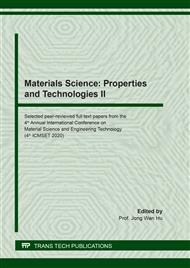[1]
J.P. Smith, D.P. Daifas, W. El-Khoury, J. Koukoutsis and A. El-Khoury, Shelf life and safety concerns of bakery products-a review, J. Critical Reviews in Food Science and Nutrition. 44 (2004) 19-55.
DOI: 10.1080/10408690490263774
Google Scholar
[2]
M.A. Teena, A. Manickavasagan, L. Ravikanth and D.S. Jayas, Near infrared (NIR) hyperspectral imaging to classify fungal infected date fruits, J. Stored Products Research. 59 (2014) 306-313.
DOI: 10.1016/j.jspr.2014.09.005
Google Scholar
[3]
A. Barreto, J.P. Cruz-Tirado, R. Siche and R. Quevedo, Determination of starch content in adulterated fresh cheese using hyperspectral imaging, J. Bioscience. 21 (2018) 14-19.
DOI: 10.1016/j.fbio.2017.10.009
Google Scholar
[4]
S. Suktanarak and S. Teerachaichayut, Non-destructive quality assessment of hens' eggs using hyperspectral images, J. Food Engineering. 215 (2017) 97-103.
DOI: 10.1016/j.jfoodeng.2017.07.008
Google Scholar
[5]
S. Teerachaichayut and H.T. Ho, Non-destructive prediction of total soluble solids, titratable acidity and maturity index of limes by near infrared hyperspectral imaging, J. Postharvest Biology and Technology. 133 (2017) 20-25.
DOI: 10.1016/j.postharvbio.2017.07.005
Google Scholar
[6]
P. Onnom and S. Teerachaichayut, Development of calibration models to predict texture and total soluble solids in jelly using hyperspectral imaging, J. AIP Conference Proceedings. 2030 (2018) 020211-1-020211-5.
DOI: 10.1063/1.5066852
Google Scholar
[7]
N. Klinbumrung and S. Teerachaichayut, Quantification of acidity and total soluble solids in guavas by near infrared hyperspectral imaging J. AIP Conference Proceedings. 2030 (2018) 020209-1-020209-5.
DOI: 10.1063/1.5066850
Google Scholar
[8]
A. Iqbal, D.W. Sun and P. Allen, Prediction of moisture, color and pH in cooked, pre-sliced turkey hams by NIR hyperspectral imaging system, J. Food Engineering. 117 (2013) 42-51.
DOI: 10.1016/j.jfoodeng.2013.02.001
Google Scholar
[9]
H.J. He, D. Wu and D.W. Sun, Non-destructive and rapid analysis of moisture distribution in farmed Atlantic salmon (Salmo salar) fillets using visible and near-infrared hyperspectral imaging, J. Innovative Food Science and Emerging Technologies. 18 (2013) 237-245.
DOI: 10.1016/j.ifset.2013.02.009
Google Scholar
[10]
S. Deng, Y. Xu, X. Li and Y. He, Moisture content prediction in tealeaf with near infrared hyperspectral imaging, J. Computers and Electronics in Agriculture. 118 (2015) 38-46.
DOI: 10.1016/j.compag.2015.08.014
Google Scholar
[11]
F. Westad, A. Schmidt and M. Kermit, Incorporating chemical band-assignment in near infrared spectroscopy regression models, J. Near Infrared Spectroscopy. 16 (2008) 265-273.
DOI: 10.1255/jnirs.786
Google Scholar
[12]
J. Yi, Y. Sun, Z. Zhu, N. Liu and J. Lu, Near-infrared reflectance spectroscopy for the prediction of chemical composition in walnut kernel, J. Food Properties. 20 (2017) 1633-1642.
DOI: 10.1080/10942912.2016.1217006
Google Scholar
[13]
A. Nawrocka and J.Lamorska, Determination of food quality by using spectroscopic methods, in: S. Grundas and A. Stępniewski (Eds.), Advances in Agrophysical Research, InTech, Croatia, 2013, pp.347-367.
DOI: 10.5772/52722
Google Scholar
[14]
L. Rodriguez-Saona, H. Ayvaz and R.L. Wehling, Infrared and raman spectroscopy, in: S.S. Nielsen (Ed.), Food Analysis, Springer nature, Cham, 2017, pp.101-127.
DOI: 10.1007/978-3-319-45776-5_8
Google Scholar


